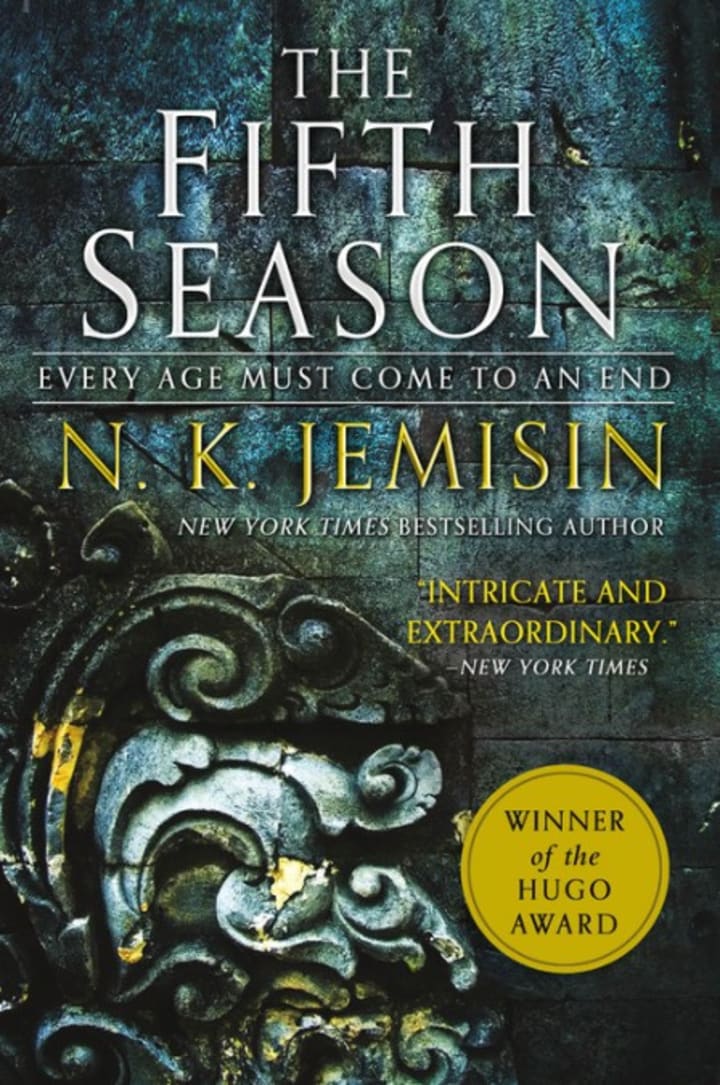The Fifth Season Book Review
The first book in N.K. Jemisin's The Broken Earth series

Where to even begin? I started this review many different ways, and none of them seemed to do The Fifth Season by N.K. Jemisin justice. How do I speak to something that is so far beyond my abilities as a writer? The world-building alone had me scraping my jaw off the floor from page one, not to mention the character development. That on its own is worthy of an essay on innovative thinking. Let's keep it simple, shall we?

The Fifth Season is the first book in the Broken Earth series. The story follows three women, Damaya, Essun, and Syenite, as they navigate life in the Stillness. In this world, volcanic upheavals create Fifth Seasons, extended winters lasting for at least six months at a time. Within the Silence are a host of people displaying various traits that allow them to survive; strongbacks are known for their physical prowess, adapting them for manual labor while ashblow hair can be used to filter volcanic ash and smoke. Chief among these traits is the ability to control the volatile magma chambers beneath the planet’s surface. These individuals, known as rogas (derogatory) or orogens (less degrading), are feared, hated, and tolerated depending on their training. This training is inflected and provided by the Fulcrum, a government organization created to harness the power of orogens.
Along with orogens, some Guardians can negate the powers of orogens via proximity. How this is possible is unexplained. Perhaps no one understands it. Oh, then there are stone eaters who are stone-like beings who can travel through the earth as if it were water.
There is an art to world-building. A few books come to mind when I think of world-building done well; The Keys to the Kingdom series by Garth Nix, The Hobbit by JRR Tolkien, and A Wrinkle in Time by Madeleine L'Engle. Each of these books takes the reader to a new land where they experience aline societies. N.K. Jemisin does this, but in a way that blew my mind. Jemisin doesn’t just introduce readers to a new world. She thrusts them into a foreign land with strange parlance, alien customs, magic, and mystery. Where some authors flog their readers with exposition or place a noob in the mix that stands in for the reader, Jemisin takes a different approach.
Information about critical elements is learned through first-hand experience. Characters are thrust into situations, and the reader learns by observing how the characters deal with these events. Another way Jemisin uses exposition is to have different characters with varying experiences with a particular element interact with said element. For example, there are three characters who all are part of the Fulcrum. Syenite is first. She had been trained by the Fulcrum, but she’s not privy to the inner workings. Alibaster understands more about the Fulcrum, but he speaks in riddles and half-truths, giving away a little more information but leaving everyone unsure. The third is Damaya, who is new to the Fulcrum and learns as she goes. Each experience builds the world a little more for the reader. We gain knowledge through the author showing us, not telling. It’s beautiful and should be a teaching manual for world-building. The whole display had me reeling until the final page.
Jemisin’s world-building is otherworldly. The Silence is alien but familiar. The character’s slang is informed by the plant’s instability. This book reminded me of the television series Serenity and Battlestar Galactica (two of my favorite Sci-fi shows). The viewer is introduced to a slice of the culture through idiomatic expressions. Jemisin doesn’t explain these expressions. She doesn’t have to be. Context clues are enough. That’s how Jemisin’s narrative unfolds. There will be no hand-holding. Pay attention as you read. It’s the only way to navigate The Fifth Season. Well, almost.
Jemisin introduces readers to a rich history in The Fifth Season. Time is broken into Seasons. Each Season is named for its effect on the planet’s ecosystems. For example, an eruption of Mount Yrga caused widespread mercury contamination known as The Heavy Metal Season. When I say “almost” concerning hand-holding, I am referring to Appendix A and B, located at the back of The Fifth Season, which contains a catalog of Fifth Seasons as well as a glossary. I bought the e-book, which means I happened to miss this detail until the end of the book (I find browsing e-books uncomfortable and clumsy, so I don’t do it). Would it have made some of the descriptions easier to grasp? Absolutely. Would I have understood what seasons are way earlier? You bet. Did not having these tools until the end hinder me at all? Heck no. Either way, Jemisin is a top-notch writer, and I can’t even imagine penning something even remotely as detailed as this book. I can’t wait to read the rest of this series. It is amazing.
If you like books that break conventions, challenge you as a reader, and take you places you hadn’t fathomed, read this book. Read it. What are you waiting for? Go read it.
About the Creator
Cynthia Varady
Aspiring novelist and award-winning short story writer. Hangs at Twtich & Patreon with AllThatGlittersIsProse. Cynthia resides in Portland, Oregon, with her husband, son, & kitties. She/Her






Comments
There are no comments for this story
Be the first to respond and start the conversation.